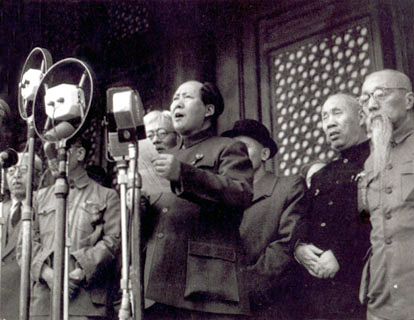Shortly after the Soviet Union developed atomic weapons, a new threat to capitalism arose in Asia.

On October 1, 1949, China became the world's second communist country. Its leader was Mao Zedong, who was sometimes called "Chairman Mao" in the United States. In the picture on the right, Mao announces the creation of the new communist state.
Mao created a form of communism called Maoism. Instead of appealing to the oppressed working classes--the poor masses slaving away in urban factories--Maoism focused on impoverished farmers in the countryside.
According to Maoism, farmers should revolt and create socialist states that share their wealth with the whole country.
Maoism (and Chinese communism in general) has always been fiercely nationalist and anti-Western. In the early 20th century, Western powers established small colonies in China, humiliating its people and dismissing its leaders.
The result was an anti-Western communist movement that finally took power in 1949. Communists in China and the Soviet Union didn't always get along--in fact, they usually fought over power and influence--but to American leaders, they were an equal threat to capitalism and democracy's survival.
Complete this activity to examine the characteristics of Maoism.
| Use the dart to pop any balloons that contain attributes or characteristics of Maoism. |
Complete
